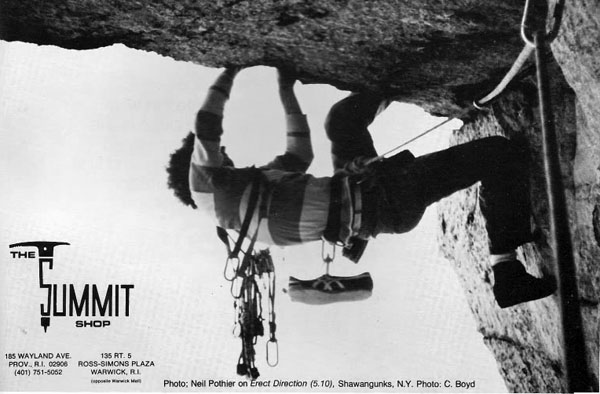
1970s Advertisement for a Rhode Island outdoor shop
Welcome to Rhode Island Climbing!
The ClimbRI website was started in 1995 to promote the sport of climbing by providing information on where Rhode Islanders can rock climb in the Ocean State and nearby Connecticut and Massachusetts. Please email me with suggestions, additions, and corrections. To meet other area climbers and to keep up with climbing meetups you should join the ClimbRI email group. There are over 400 climbers in the group from RI, CT, and MA and there are always people arranging climbing in all seasons.
Climbing in "Little Rhody" means climbing on diminutive cliffs or peeble wrestling on boulders. In the climbing community the state is only known for bouldering, primarily in Lincoln Woods. This web site does not include bouldering, only climbing. I defer to boulderers to cover that and recommend Mountain Project as a source. There is a joke among locals that the best Rhode Island climbing areas just happen to be in Connecticut. The two main climbing areas for Rhode Islanders are Ross Rocks, which is four miles from the RI border, and Lantern Hill which is eight miles from the border. Considering that Rhode Island is only 35 miles wide these areas are closer to Rhode Island than most climbers in Connecticut.
This history page is a work-in-progress. I am adding to it as I gather information. If you have any knowledge of the history of climbing in Rhode Island, especially first ascents, I will appreciate it if you email me.
Early Years
Organized rock climbing started in Rhode Island in the 1930s when the Appalachian Mountain Club (AMC) Narragansett Chapter organized climbs to local cliffs. This early history is documented in a 1935 Appalachia article entitled Rhode Island, the Rock Climbers' Paradise.
I have little information on Rhode Island climbing in the 1940s through 1960s although the old pitons still in place at Pettaquamscutt Rock, Fox Den, and Ross Rocks could have come from this era. The old soft iron pitons (Italian and Austrian Stubai ring pitons) at Diamond Hill were put in by Albrecht (Al) Hofmann and Ray Fletcher in roughly the period 1962-1966.
1970s and 80s
In the 1970s and 80s there was a flurry of activity with climbers adopting local cliffs and writing guidebooks. Gary Peterson produced the Rock Climbing Guide to southern Rhode Island in 1978 and is republished here with the permission of the author. Ron Rocha and Allan Li published A Climber's Guide to DIAMOND HILL Cumberland, R.I. in 1980 and is republished here with the permission of the author. Ed Sewall wrote ROCK CLIMBS OF SNAKE DEN STATE PARK JOHNSTON, RHODE ISLAND in 1987 (published in 1991) and is republished here with the permission of the author. There was a climbing magazine published in Rhode Island by Paul Baird called North American Climber. It was short lived with only four issues being produced from 1975 to 1977..
This was the era of the "Rhodey Loadies." They were Rhode Island's equivalent of the Vulgarians at the Gunks. Like the Vulgarians they were a loosely knit group known as much for their partying as their climbing. The Rhodey Loadies and the Ozone Alpine Club from South County were the pioneers of modern day climbing in Rhode Island establishing many of the routes throughout the State in the 1970s and 80s. Paul Baird, John "Whitey" MacLean, Neil Pothier, Ed Sewall, Andrew Sornborger, Ward and Chris Smith, Steve Landry, Steve Wood, and Gary Peterson are a few of the climbers who made their mark on Rhode Island climbing during this era.

1970s Advertisement for a Rhode Island outdoor shop
1990s
The explosion in new climbers in Rhode Island, was like everywhere else, due largely to the emergence of rock gyms. The Rhode Island Rock Gym was the first in the state. It was started by Joe Goodreau and Bruce Foster in 1992. Larry Norin and Nadav Minkin bought the gym in 1998.
On the trad scene the Appalachian Mountain Club (AMC) Narragansett Chapter was also responsible for introducing many local climbers to the sport. Peter Barlow, the chairman of the AMC Technical Climbing Committee probably introduced more local climbers to rock and ice climbing than any other single person.
The Rhode Island Climbing web site (this one) was brought online in 1995. The climbri email group quickly became the primary means of communication among local climbers.
2000s
Led largely by Joe McLoughlin bouldering at Lincoln Woods put Rhode Island on the national climbing map. Joe penned an article on Lincoln Woods that appeared as a "MiniGuide" in the April 2000 issue of Rock & Ice and he wrote the guidebook A Bouldering Guide to Lincoln Woods, RI. The area gets occasional mentioned in both Rock & Ice and Climbing magazines.
In 2006 the Rhode Island Climbing gym moved to a new facility in Lincoln and changed its name to RockSpot.
2010s
In 2013 RockSpot Climbing opened a new rock gym in Peace Dale, RI in 2017 Central Rock opened a gym in Warwick, and in 2018 Rock Spot opened a bouldering facility in Providence. There are now four rock gyms in Rhode Island.
In this decade sport climbing started making inroads in nearby Connecticut despite years of being dictated by one terrorist bolt chopper. An April 2013 Rock and Ice article on sport climbing in Connecticut written by Brian Phillips caused the local bolt chopper to chop two routes at Rhode Island's primary climbing area, Ross Rocks.